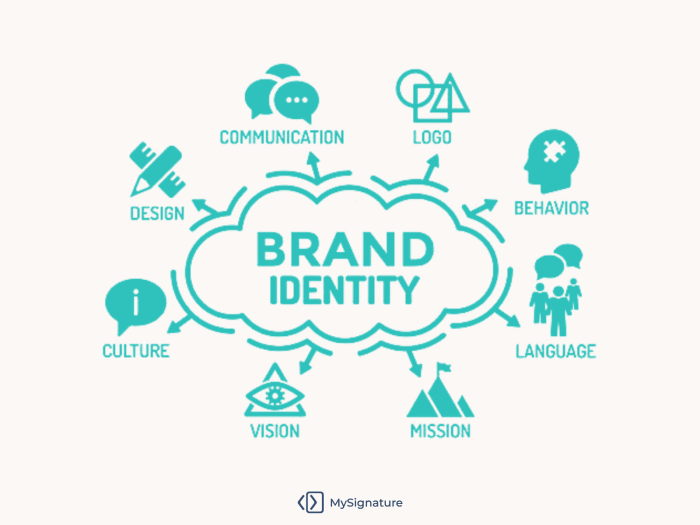Brand Identity Building sets the stage for businesses to stand out in a crowded market, showcasing their unique essence and values. Think of it as the ultimate branding playbook, guiding companies on their journey to recognition and success.
In a world where competition is fierce and attention spans are short, establishing a solid brand identity is the key to making a lasting impact and connecting with your target audience on a deeper level.
Importance of Brand Identity Building

Building a strong brand identity is essential for businesses to stand out in a crowded marketplace and create a lasting impression on consumers. It helps establish trust, credibility, and recognition, ultimately leading to increased customer loyalty and sales.
Examples of Successful Companies with Strong Brand Identity
- Apple: Known for its sleek design, innovation, and customer-centric approach, Apple has successfully built a brand identity that resonates with consumers worldwide.
- Nike: With its iconic “Just Do It” slogan and the famous swoosh logo, Nike has created a powerful brand identity associated with athleticism, empowerment, and performance.
- Coca-Cola: Coca-Cola’s consistent branding, emotional storytelling, and timeless logo have helped the company become one of the most recognizable and beloved brands globally.
Differentiation from Competitors
A strong brand identity sets a company apart from its competitors by creating a unique personality, values, and visual elements that consumers can easily identify and connect with. It helps build a strong emotional connection with customers, leading to brand loyalty and preference over other options in the market.
Elements of Brand Identity

Building a strong brand identity requires attention to various key elements that help define the brand and make it recognizable to consumers. Let’s explore the role of logos, color schemes, typography, and brand voice in shaping a brand’s identity, and how consistency across these elements is crucial for establishing a cohesive brand image.
Logos
Logos are visual representations of a brand and often the first thing consumers associate with a company. A well-designed logo should be memorable, versatile, and reflective of the brand’s values and personality. It serves as a symbol that helps consumers identify and connect with the brand.
Color Schemes
Color plays a significant role in brand recognition and evokes specific emotions and associations. A carefully chosen color scheme can communicate the brand’s message effectively and create a cohesive visual identity. Consistency in color usage across various brand touchpoints helps reinforce brand recognition.
Typography
Typography refers to the style and appearance of text used in branding materials. The choice of fonts, sizes, and spacing can convey the brand’s tone and personality. Consistent typography helps create a unified look and feel across different communication channels, enhancing brand recognition.
Brand Voice
Brand voice encompasses the language, tone, and style used in brand messaging. It reflects the brand’s personality and values, shaping how consumers perceive and connect with the brand. Consistency in brand voice across all communication channels helps build trust and loyalty among consumers.
Consistency Across Elements
Maintaining consistency across logos, color schemes, typography, and brand voice is essential for building a strong brand identity. Consistent use of these elements creates a unified brand image that is easily recognizable and memorable to consumers. It reinforces the brand’s values and messaging, establishing a sense of trust and credibility.
Developing a Brand Identity Strategy: Brand Identity Building
Creating a brand identity strategy is crucial for establishing a strong and recognizable brand in the market. It involves a series of steps aimed at defining the core values, messaging, and visual elements that represent the brand.
Understanding the Target Audience
Identifying and understanding the target audience is essential in developing a brand identity strategy. By knowing who your customers are, their preferences, behaviors, and needs, you can tailor your brand messaging and visuals to resonate with them effectively.
- Conduct market research to gather data on the demographics, psychographics, and buying habits of your target audience.
- Develop buyer personas to create detailed profiles of your ideal customers, including their goals, challenges, and preferences.
- Use social listening tools to monitor conversations and feedback about your brand to gain insights into customer sentiment and perception.
Market Research in Shaping Brand Identity, Brand Identity Building
Market research plays a vital role in shaping a brand’s identity strategy by providing valuable insights into the competitive landscape, industry trends, and consumer preferences.
- Identify market gaps and opportunities through competitor analysis to differentiate your brand and create a unique value proposition.
- Analyze consumer trends and behaviors to anticipate changes in the market and adjust your brand positioning accordingly.
- Gather feedback from customers through surveys, focus groups, and customer interviews to understand their perception of your brand and identify areas for improvement.
Brand Identity and Customer Perception
When it comes to brand identity, it’s not just about logos and colors. The way customers perceive a brand plays a crucial role in shaping their trust and loyalty towards it. Let’s dive into how brand identity influences customer perception.
The Power of Brand Identity
A well-defined brand identity can create a strong emotional connection with customers, leading to increased trust and loyalty. When a brand consistently delivers on its promises and values, it builds credibility and fosters positive perceptions among customers.
- Consistency is key: Brands like Apple and Nike have successfully shaped customer perception by maintaining a consistent brand identity across all touchpoints. From their messaging to visual elements, everything aligns with their core values and resonates with their target audience.
- Emotional appeal: Brands like Coca-Cola and Disney have mastered the art of evoking emotions through their brand identity. Whether it’s nostalgia, happiness, or excitement, these brands have created a strong emotional bond with customers, influencing their perception and loyalty.
- Storytelling: Brands like TOMS and Patagonia have built a compelling brand narrative that resonates with customers on a deeper level. By sharing their values and mission through storytelling, they have successfully shaped customer perception and gained loyal followers.
